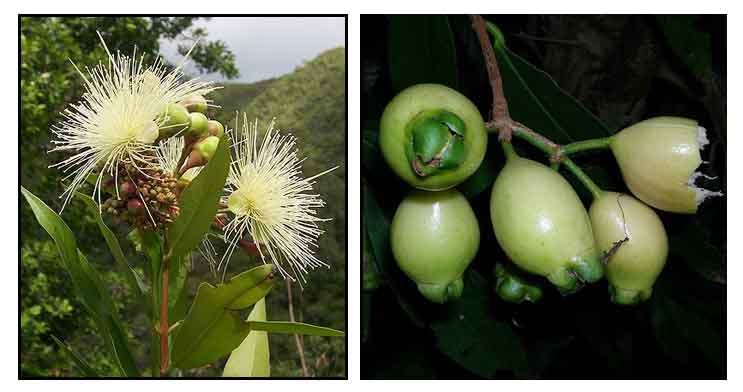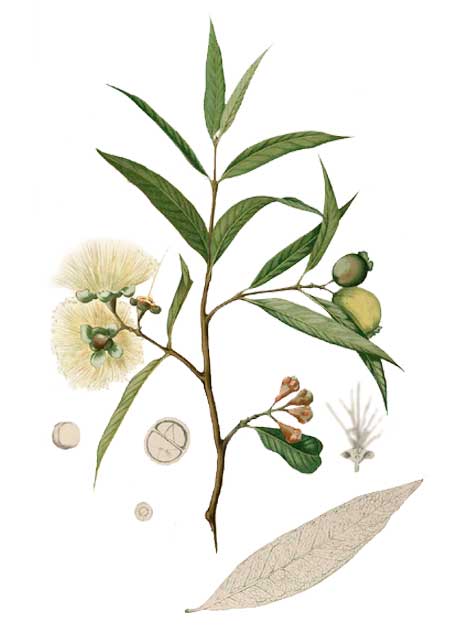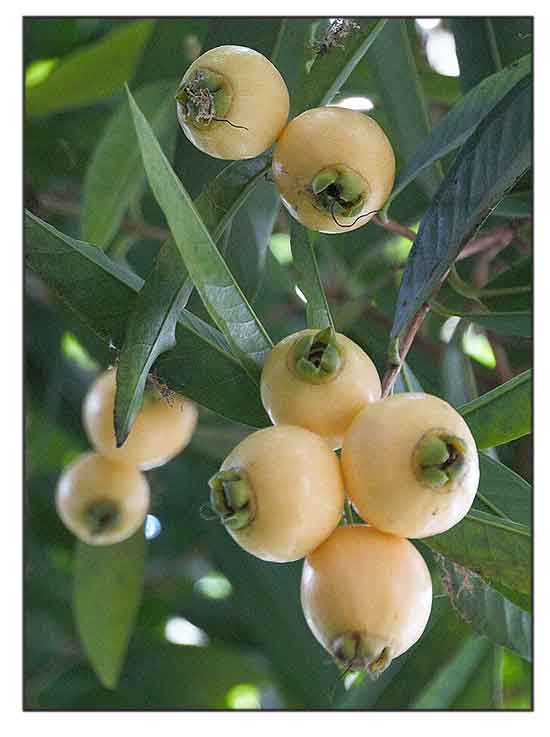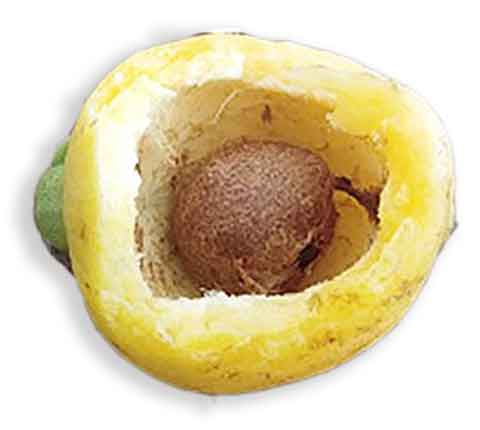 Gen info Gen info
• Syzygium is a genus of flowering plants belonging to the myrtle family, Myrtaceae, comprising about 1200-1800 species.
• Etymology: The genus name Syzygium derives from Greek suzugos, meaning "joining together or conjunction". Syzygium used to be the name of a Jamaican plant species with paired leaves and branches. Specific epithet jambos is mix of derivations from Portuguese and Latin, which is from Malay jambu from Sanskrit jambuh meaning "pink apple".
• The common name Yambo is the namesake of Lake Yambo, one of the Seven Lakes of San Pablo City, Laguna. (32) The common name Rose Apple refers to the rosewater that can be distilled from the fruits. (33)
 Botany Botany
• Tampoi is a small tree growing to about 8 meters high. Leaves are narrowly oblong or elliptic-lanceolate, 12.5 to 20 centimeters long, 2 to 4 centimeters wide, narrowed at both ends. Flowers are large, strongly scented, greenish-white, 5 to 7 centimeters across, borne in groups of 2 to 8 at the ends of twigs. Fruit is rounded, 3.5 to 5 centimeters diameter, dull yellow and tinged with pink. Seeds are up to 2.5 centimeters long, ellipsoid to oblong, narrowed at the middle.
• Syzygium jambos is a large shrub or small-to-medium-sized tree, typically 3 to 15 meters (10 to 49 feet) high, with a tendency to low branching. Leaves and twigs are glabrous. Bark is dark brown, fairly smooth, with little relief or texture. Leaves are lanceolate, 2 to 4 centimeters (3â„4 to 1 5â„8inches) broad, 10 to 20 cm (4 to 8 in) long, pointed, base cuneate with hardly any petiole, lively red when growing, but dark, glossy green on attaining full size. Flowers are in small terminal clusters, sometimes described as fragrant, white or greenish white, the long, numerous stamens giving them a diameter of 5–8 cm (2–3+1â„4 in). Fruit is shaped like some kinds of guava, often mistaken for one on sight. However, the fragrance, flavor and texture are different. Unlike the many-seeded guava, the fruits contains one or two large, unarmored seeds, about 1 cm diameter, lying loose in a slightly fluffy cavity when ripe, the ripeness indicated by a rattle of the seeds on shaking. Skin is thin and waxy. (32)
Distribution
- Introduced.
-
Cultivated as a shade tree, in and about towns throughout the Philippines.
- Occasionally naturalized.
- Prehistoric introduction.
- Native to Borneo, Cambodia, China, Laos, Lesser Sunda Is., Malaya, Myanmar, Sumatera, Thailand, Vietnam. (16)
 Constituents Constituents
- Bark contains tannin, 12.4 %.
- Bark yields an alkaloid, jambosine.
- Root bark contains jambosine and oleoresin.
- Fruit contains 3.45% dextrose; the seeds, 3% tannin and 0.019% gallic acid.
- Leaves yield a yellow essential oil, yielding 26.64% di-a-pinene and 23.84% l-limonene.
- Study of leave extracts yielded three dihydrochalcones, phloretin 4'-O-methylester(2'6'-dihydroxy-4-methoxydihydrochalcone (1), myrigalone G (2',6'-dihydroxy-4'-methoxy-3'-methyldihydrochalcone) (2) and myrigalone B (2′,6′-dihydroxy-4′-methoxy-3,5′ dimethyldihydro-chalcone) (3). (see study below) (5)
- Nutrient analysis of raw rose-apple (per 100 g) yielded: (Proximates) water 93 g, energy 25 kcal, protein 0.60 g, total lipid (fat) 0.30 g, carbohydrate 5.70 g; (Minerals) calcium 29 mg, iron 0.07 mg,
magnesium 5 mg, phosphorus 8 mg, potassium 123 mg, sodium 0, zinc 0.06 mg; (vitamins) vitamin C 22.3 mg, thiamin 0.020 mg, riboflavin 0.030 mg, niacin 0.800 mg, vitamin B12 0 µg, vitamin A RAE 17 µg, vitamin A 339 IU; (Lipids) total trans fatty acids 0, cholesterol 0 mg. (18)
- Ethanol and chloroform leaf extracts yielded a total phenolic content of were 42.72 ± 0.07 and 31.06 ± 1.4 GAE/g, respectively. (see study below) (20)
- Phytochemical screening of methanolic extract of leaves yielded carbohydrates +++, phenols +, flavonoids +++, tannins +, steroids ++, terpenoids ++, alkaloids +, saponins +, amino acids ++. (see study below) (22)
- Study S. jambos fruit tree yielded seven new phloroglucinol derivatives (1-7) together with four known triterpenoids (8-11) and two known flavones (12 and 13). Compounds 1-7 were elucidated as jambone A (1), jambone B (2), jambone C (3), jambone D (4), jambone E (5), jambone F (6), and jambone G (7). (see study below) (23)
 - Phytochemical screening of leaves and bark extracts yielded polyphenols, anthraquinones, tannins, and steroids. (see study below) (27) - Phytochemical screening of leaves and bark extracts yielded polyphenols, anthraquinones, tannins, and steroids. (see study below) (27)
- Study of stems of Syzygium jambos var. jambos yielded twelve compounds from EtOAc and MeOH extracts viz., alphitolic acid (1), urolithin A (2), dibutyl phthalate (3), betulinic acid (4), ursolic acid (5), 1-(4-methoxyphenyl)-1, 2-propanediol (6), 2, 6-dimethoxy-1, 4-benzoquinone (7), diisobutyl phthalate (8), β-sitosterol (9), 3-acetyl-ursolic acid (10), asiatic acid (11), and arjunolic acid (12). (see study below) (29)
- Study of methanol extracts and fractions of dried stem barks of S. jambos by vacuum liquid chromatography (VLC) isolated three compounds: VLC fraction 6-pentacyclic triterpenes (SJ-61); VLC-F9, a sitosterol (SJ-92); and VLC-F16, a triterpene 3-nor-,2,3-fridelan derivative (SJ-184). Structure of the three compounds were elucidated as ß-sitosterol, friedelin, and 3-nor-2,3-secofriedelan derivative (proposed). (see study below) (33)
- GC-MS study of leaves for volatile oil yielded 15 compounds. Major compounds were ß-caryophyllene, (E,E)-α-farnesene and cariophyllene alcohol. (35)
- Study of fruit and seed for mineral content yielded (mg/100g): calcium 12.71 and 23.72, sulphur 10.31 and 12.73, phosphorus 11.63 and 14.62, manganese 0.045 and 0.093, selenium (below detection limit), iron 0.73 and 1.15, sodium 0.71 and 0.79, potassium 45.62 and 329.32, lead 0.022 and 0.022, zinc 0.24 and 0.39, iodine (below detection limit), copper 0.067 and 0.186. (36)
- GC-MS analysis of fruit identified 80 volatile compounds: 12 hydrocarbons, 8 oxides and acetals, 12 aldehydes, 9 ketones, 5 esters, 31 alcohols, 3 acids. Among identified compounds, geraniol, nerol, ß-phenylethyl alcohol, linalool, hotrienol, citronellol, four linalool oxides (furans and pyrans), rose oxides and nerol oxide are well-known components of Bulgarian rose oil. Other compounds, (E)- and (Z)-cinnamaldehydes and their alcohols and acetates, 3-phenylpropyl alcohol and 3-phenyl propanol are responsible for the cinnamon-spicy-like note of the fruit. (44)
Properties
- Flowers sometimes described as fragrant. Fruit has a floral bouquet. a faint odor of rose.
-
Considered as digestive, stimulant, cooling.
-
Flowers considered cooling.
- Studies have shown antioxidant, antibacterial, antifungal, antinociceptive, antifungal, hypotensive, anti-inflammatory, antidermatophytic, cardioprotective, antinociceptive, antiviral, hepatoprotective, cytotoxic, antidiabetic, anti-acetylcholinesterase, anti-quorum sensing, antiurolithiatic properties.
Toxicity concerns
- Seeds are said to be poisonous.
- Roots, stems, and leaves reported to yield an unknown amount of hydrocyanic acid.
- Jambosine, an alkaloid, has been found in the bark and roots. (17)
Parts used
Whole plant.
Uses
Edibility
- Fruit is dry, somewhat sweet, with a faint odor of rose.
- Commonly eaten right out, it is also used in making stews, preserves, jellies and jams.
- In Jamaica, sliced fruits are candied by stewing in cinnamon-flavored heavy sugar syrup.
Folkloric
- In Indo-China, all parts are used as stimulant, digestive and as a remedy for tooth problems.
- In Upper Burma, leaves are boiled and used as a remedy for sore eyes.
- Powdered leaves rubbed on the body in smallpox.
- Leaf decoction used as diuretic, expectorant, and treatment for rheumatism.
- In Cambodia, infusion of leaves given for fever.
- In India, used to treat infections. Fruit is used as tonic for the brain and liver; infusion used as diuretic.
- Conserve of flowers considered cooling.
- Fruit infusion used as diuretic.
- Seeds and fruits used for diarrhea, dysentery, diabetes, and catarrh.
- In El Salvador, pulverized seeds used for diabetes.
- In Brazil, decoction of leaves used for diabetes.
- In Columbia, seeds used for its anesthetic property.
- In Cuba, roots used for epilepsy.
- In Ayurveda, plant pacifies vitiated pitta, diarrhea, colic, wounds, ulcers, stomatitis, and general debility.
- In Homeopathy, used for acne, nausea, headache, heartburn, abdominal colic, fever, diarrhea.
- Seeds used for dysentery, diarrhea, and catarrh. Juice from macerated leaves used for fever. Infusion of powdered leaves used for diabetes. Leaf decoction applied to sore eyes; also as diuretic, expectorant, and to treat rheumatism. Bark decoction used for asthma, bronchitis, hoarseness. Plant used for hemorrahge, leprosy, wounds, ulcers, fever and pains. (34)
Others
- Ritual: In Buddhism, the Rose Apple Tree is considered sacred, referred to as the Enlightenment Tree.
- Tanning / Dye: Bark used for tanning and yields a brown dye. (17)
- Timber: Used to make furniture, construction beams, frames for musical instruments. Also planted as a living fence post.
- Perfumery / Essential oil: Essential oil distilled from leaves used in perfumery.
- Apiculture: Flowers are a rich source of nectar for honeybees. (17)
- Fuel: A good source of small food for fuel; a good source of charcoal.
Studies
• Antibacterial / Cytotoxicity / Leaves: Study evaluated methanol extracts of S jambos leaves for antimicrobial activity and toxicity. The leaf extract inhibited 4 of 14 gram-positive and gram-negative test bacteria, with Gram-positive bacteria showing more susceptibility. The leaf extract also showed toxicity in Artemia franciscana bioassay. Results support the use of S. jambos leaf decoction as antiseptic agents. (1)
• Antinociceptive: Study showed Syzygium jambos extract has remarkable analgesic effects on both cutaneous and deep muscle pain not mediated by opioid receptors in an efficacy higher than that shown by diclofenac. (2)
• Antimicrobial / Tannins: Study show SJ extracts showed antibacterial activity against S aureus, Y enterocolitica, Coagulase-negative staph. The activity seemed related to the high tannin content. (3)
• Antidermatophytic / Triterpenoids: Study yielded known triterpenoids - friedelin, ß-amyrin acetate, betulinic acid and lupeol. Results showed antidermatophytic activity against three species: Microsporum audounii, Tricophyton soudanense and T mentagrophytes. (4)
• Radical Scavenging / Dihydrochalcones: Study of leave extracts yielded three dihydrochalcones - phloretin 4'-O-methylester(2'6'-dihydroxy-4-methoxydihydrochalcone (1), myrigalone G (2) and myrigalone B (3),which showed radical scavenging properties towards the DPPH assay. (5)
• Hypotensive / Leaves: Study of aqueous fraction of the young boiled leaves extract of Syzygium jambos, treated with ethyl acetate, has an important hypotensive effect. (6)
• Antimicrobial: Study evaluated the antimicrobial efficacy of S. jambos against 8 different microorganisms, viz., S aureus, B subtilis, E Coli, K pneumonia, P vulgaris, P aeruginosa, S typhi and V cholera. Different extracts showed varying degrees of inhibitory activity. Overall the acetone extract was found to be more effective. (8)
• Antioxidant / Hepatoprotective / Leaves: Study evaluated the leaves of Syzygium jambos for antioxidant activity in vitro and hepatoprotective activity in vivo. The extract showed significant dose-dependent antioxidant activity and hepatoprotective activity in CCl4-induced liver damage. (11)
• Aroma Compounds / Fruit: Study evaluated the rose apple fruit for aroma compounds. Results yielded medium and high volatility components. Hexanal, 3-penten-2-one, hexanol, (Z)-3-hexen-1-ol, linalool, isovaleric acid, benzyl alcohol, 2-phenylethylalcohol and (E)-cinnamaldehyde were potent odorants contributing to the headspace aroma. (12)
• Antibacterial / Anti-Inflammatory / Acne Vulgaris: Acne is considered a chronic skin disorder resulting from the production of reactive oxygen species due to involvement of Propionibacterium acnes in the skin. Study showed S. jambos possesses antibacterial, antioxidant, and anti-inflammatory effects warranting clinical studies for use as possible alternative anti-acne agent. (13)
• Leaf Essential Oils / Anti-Inflammatory / Acne Vulgaris: Study showed the main factor that influenced the chemical composition of leaf essential oil was the collection period. Results also suggest composition was influenced mainly by foliar nutrients (N, Mn, Co, Fe, S, and Mg) and soil nutrients (Na, Al, S, and H+Al). (14)
• Antioxidant / Ripe and Unripe Fruits: Study showed the rose apple pulp extract in ripe state has lower antioxidant and free radical scavenging activity than that found in unripe state. However, both show benefit as natural antioxidants. (15)
• Antifungal / Seeds and Leaves: Study evaluated aqueous and solvent extracts of 8 medicinal plants for antifungal activity against three human pathogenic fungi. Aqueous extracts of seeds of Syzygium jambos exhibited antifungal activity with 16 mm zone of inhibition against Candida albicans, 28.75 against Microsporum canis, 3025 against Microsporum gypseum. (19) In an in vitro study of leaf extracts for antifungal activity, S. jambos showed significant inhibition against C. neoformans with IC50 values of 34.36 µg/mL. 80-100 µg/mL at MIC >1000 µg/mL was the inhibitory level of S. jambos against all five fungus pathogens. (25)
• DPPH Radical Scavenging Activity / Leaves: Study evaluated leaf extracts for total polyphenol and flavonoid content and DPPH quenching by in vitro method. Total phenolic content of ethanol and chloroform leaf extracts were predicted as 42.72 ± 0.07 and 31.06 ± 1.4 GAE/g of extract, respectively. A positive radical scavenging correlation was exhibited by polyphenolic contents of ethanolic, chloroform, and methanolic extracts. (20)
• Hepatoprotective / Paracetamol Induced Toxicity / Leaves: Study evaluated the hepatoprotective activity of methanolic extract of S. jambos leaves against paracetamol induced hepatic damage in Wistar albino rats. Results showed dose-dependent hepatoprotective activity. Histopathology showed improved cytoarchitecture of liver cells in the treated group. (21)
• Antioxidant / Leaves: Study evaluated the antioxidant activity of a methanolic extract of S. jambos leaf in paracetamol intoxicated Wistar albino rats. Results showed significant antioxidant activity as evidenced by elevated levels of antioxidant enzymes in blood and tissues of treatment groups. (22)
• Phloroglucinol Derivatives / Cytotoxic and Antioxidant: Study S. jambos fruit tree yielded seven new phloroglucinol derivatives (1-7) together with four known triterpenoids (8-11) and two known flavones (12 and 13). Compounds 10 and 11 showed potent cytotoxic activities on melanoma cells and compounds 1, 2, 4-7, and 13 exhibited weak antioxidant activities. (see constituents above) (23)
• Antidiabetic /
Enhanced Glucose Uptake in Skeletal Muscle: Study investigated the in vitro glucose uptake of hydromethanolic leaves extract of S. jambos on L6 Cell lines. Results showed enhancement of glucose transport in L6 myotubes. The extract exhibited significant glucose uptake (% glucose uptake 113+12.26) compared with standard insulin (131±17.57). Results suggest a potential for the prevention of diabetic complications such as nephropathy, retinopathy and cancer. (25)
• Anti-Diabetic / Improved Glucose Modulation: Study evaluated the phytochemical profiles and hypoglycemic effects of T. ananassae, C. speciosus, and Syzygium jambos. S. jambos showed the greatest concentration of phenolics. Mice treated with the plant extracts showed better glucose modulation when the extracts were administered in complement with an insulin injection. Mice on T. ananassae and S. jambos showed better glucose modulation over time. (26)
• Antibacterial / Antibiotic Modulating Against Resistant Phenotypes / Bark and Leaves: Study evaluated the antibacterial activity of methanol extracts of bark and leaves of S. jambos and their synergistic effects with selected antibiotics against drug-resistant Gram-negative and Gram-positive bacteria. Leaf extract was active against all 26 strains of S. aureus and all 21 strains of Gram-negative bacteria tested, with MIC range of 32-512 µg/mL, the lowest against S. aureus MRSA9 strain. In the study, antibiotic modulating activity of the extracts at MIC/2 on more than 70% tested strains of S. aureus was obtained with associated of leaf and bark extracts with chloramphenicol. The antibiotic modulating activity was also seen with combination of the leaf and bark extracts with antibiotics. Results suggest both extracts can be used as antibiotics resistance modulators, providing a new alternative in bacterial infections involving resistant phenotypes. (27)
• Variability of Essential Oil / Leaves: GC-MS study of leaf essential oil from ten specimens showed EO composition was influenced by foliar nutrients (N, Mn, Co, Fe, S, and Mg) and soil nutrients (Na, Al, S and H+Al). A total of 62 compounds were identified. Compound with the best model obtained was (E)-caryophyllene, with a coefficient of determination equal 0.8113. (28)
• Chemical Constituents / Absence of Cytotoxicity Against Human Liver Cancer Cells Huh-7 / Stems: Study of stems of Syzygium jambos var. jambos yielded twelve compounds from EtOAc and MeOH extracts. None of the tested compounds i.e., 1, 7, 10, and 11+12 showed cytotoxic activity against Huh-7 cells. (see constituents above) (29)
•
Potential in Treatment of Sickle Cell Disease (SCD): Protein disulfide isomerase (PDI) is an oxidoreductase that mediates thio/disulfide interchange reactions, reported to play a critical role in thrombus formation following vascular injury. PDI inhibition has been proposed as a promising therapeutic approach to ameliorate vascular and hematological complications of SCD. This study evaluated in vitro PDI activity in the presence of S. jambos aqueous leaf extract. The extract showed a dose-dependent anti-PDI activity with IC50 of 14.40 µg/mL. The extract also reduced ET-1 (endothelin-1) stimulated ROS to baseline levels (p<0.05). Results suggest S. jambos may represent a novel pharmacological approach to treat complications of SCD. (30)
• Delta-ALA-D Inhibitory Potential / Antioxidant / Protective Action on Stressed Erythrocytes / Leaves: Study evaluated the effect of S. jambos and Solanum guaraniticum leaf extracts on delta-aminolevulinate dehydratase (delta ALA-D) activity, antioxidant activity, and protective action on oxidatively stressed erythrocytes. Both extract inhibited delta-ALA-D activity. S. jambos leaf extract exhibited marked efficiency in countering H2O2-induced lipid peroxidation and maintaining cellular integrity against AAPH-induced hemolysis. S. jambos also showed greater H2O2 scavenging activity and stronger reducing power. (31)
• Bioactivities / Cytotoxicity by Brine Shrimp Lethality Assay/ Fractions / Stem Bark: Study of methanol extracts and fractions of dried stem barks of S. jambos by vacuum liquid chromatography (VLC) isolated three compounds. In brine shrimp lethality assay, LC50s for crude methanolic extract, carbon tetrachloride, chloroform, and n-hexane soluble fractions of ME were 6.97, 18.07, 64.943, 247.596 and 12.75µg/ml, respectively. Chloroform soluble fraction and carbon tetrachloride soluble fraction showed mild to moderate antimicrobial activity. Methanolic extract of stem barks and chloroform soluble fraction showed significant free radical scavenging activity. (see constituents above) (33)
• Anti-Herpes simplex Virus Activity / Leaves: Study evaluated hexane, dichloromethane and methanol extracts of leaves of S. jambos for anti-herpes simples virus type 1 and 2 activity (HSV-1 and HSV-2) using plaque reduction assay. Hexane and dichloromethane extracts exhibited anti-HSV1 and HSV-2 activities with more than 50% inhibition of plaque formation at concentration of 100 µg/ml. The dichloromethane extract showed highest activity against HSV1 and HSV2 with IC50s of 75 µg/ml. Cytotoxicity in Vero cells of hexane and methanol extract showed CC50 values of 150 and 600 µg/ml, respectively. (37)
• Cardioprotective / Inhibition of Biomarkers of Endothelial Cell Activation / Leaves: Study evaluated the effects of S. jambos extract of leaves on biomarkers of endothelial dysfunction and immune responses in the human endothelial cell line, EA.hy926. Incubation of EA.hy926 cells with ET-1 lead to a 6.5 fold increase in IL-6 expression by qPCR, which was blocked by S. jambos ET-1 stimulation led to a significant increases in ROS production that were sensitive to S. jambos. Results suggest a novel cardiovascular protective pharmacological approach to regulate endothelial cell activation, IL-6 expression, and immune cell responses. (38)
• Antibacterial Endophytic Fungi / Stem Bark: Study evaluated the antibacterial activity of endophytic fungi isolated from stem bark of jambu mawar (Syzygium jambos) by disc diffusion method against Gram-positive S. aureus and B. subtilis and Gram-negative E. coli and S. typhi. Eight endophytic fungi, SJ1-SJ8, were obtained from the stem bark. SH6, identified as Fusarium verticillioides, showed highest activity. Pure compounds isolated as yellowish-white solids showed good antibacterial activity against S. aureus and S. typhi with MICs of 64 g/mL each. (39)
• Antiurolithiatic / Leaf Extracts / ZnO Nanoparticles: Study evaluated the antiurolithiatic activity of leaf extracts of S. jambos and its zinc oxide nanoparticles (ZnONPs) both in vivo and invitro using ethylene glycol induced urolithiatic model in rats and growth inhibition study of struvite crystals, respectively. Results showed the leaf extracts and ZnONPs prevented the growth of urinary stones. Further studies were suggested for pharmacologic action and mechanism. (40)
• Antibacterial against MDR Pathogens / Leaves and Fruits: Study evaluated methanol extracts of fruits and leaves for antimicrobial potentiality of S. jambos against five different MDR bacterial strains i.e., E. coli, Acinetobacter spp., Shigella sonnei, Klebsiella spp. and Pseudomonas spp. using agar well diffusion method. Both extracts showed promising activity against all tested organisms with maximum zone of inhibition at 800 µg dose for both extracts. The methanolic leaf extract showed maximum ZOI of 15 mm against Shigella sonnei and 13.5 mm against Klebsiella spp. Fruit extract showed maximum ZOI of 10 mm against E. coli. Prominent effects were attributed to higher tannin content. (41)
• α-Amylase and α-Glucosidase Inhibitory Activity: Study compared the α-amylase and α-glucosidase inhibitory effects of different plant parts (root, stem, leaf, seed, flower and flesh) of S. jambos. Acarbose was used as positive control. Evaluation of α-amylase inhibition used in vitro inhibition method and α-glucosidase used yeast and small intestine in mice. Among different parts of S. jambos, seeds showed strongest inhibitory effects on activities of α-glucosidase and α-amylase. Results suggest potential for treatment of diabetes or health food. (42)
• Anti-Quorum Sensing Activity against Pseudomonas aeruginosa: Pseudomonas aeruginosa is recognized as a multidrug resistant opportunistic infection causing severe chronic infection in immune-compromised patients. Production of numerous virulence factors and biofilm formation in P. aeruginosa is regulated by cell-to-cell communication known as quorum sensing (QS). Study evaluated the anti-QS property of ethanolic leaf extract of S. jambos in inhibiting the QS-regulated virulence traits. At sub-MIC concentration, the extract attenuated the production of virulence determinants and biofilm formation. Bioactive compounds contributing to anti-QS efficacy were identified as Betulin and 5-hydroxymethyl-2-furfural (HMF). Molecular docking of the compounds revealed relatively strong binding affinity of the phytoconstituents for transcriptional activators of the QS circuit in P. aeruginosa. Results suggest potential of S. jambos and its bioactive components as QS antagonist in the treatment of chronic infections caused by P. aeruginosa. (43)
• Anti-Acetylcholinesterase Activity: In vitro and in-silico studies evaluated the anti-acetycholinesterase activity of Macaranga tanarius and Syzygium jambos. A previous work showed Syzygium jambos exhibited 93.81% inhibition against acetycholinesterase (AChE) at 50 µg/ml concentration of hexane fraction. Bioassay-guided isolation yielded anacardic acid derivatives (4,5) from S. jambos. Compound 5 showed strongest anti-AChE potential (IC50 0.54 µM); compound 4, 2.4 µM. In silico molecular docking revealed compound 5 formed stronger molecular interactions. Results suggest potential remedy in neuroprotection. (45)
• Antidiabetic / Bark: Study evaluated the antidiabetic potential of an aqueous bark extract of S. jambos using doses of 750, 1500, and 2250 mg/kg p.o. on normoglycemic and STZ-induced diabetic rats. The highest dose significantly lowered blood glucose level in streptozotocin-induced diabetic rats, impaired normal glucose absorption from intestine and following glucose challenge, with no change in glycogen content of liver and skeletal muscle. The bark extract also showed marked antioxidant activity in vitro. Chronic administration of the bark extract did not induced clinical signs of toxicity, hepatotoxicity or renotoxicity, but evoked an encouraging lipid profile. Results suggest the bark extract is well tolerated and possess oral acute antihyperglycemic activity and hypoglycemic activity with chronic treatment. (46)
• Cytotoxic Activity in Liver Cancer Cell Line / Leaves: Study evaluated S. jambos leaves extract for its effect on HepG2 liver cancer cell line and its molecular level of action. Results showed the extract works at an intracellular level and influences the apoptotic cell cycle pathway positively through Bcl-2 and Bax gene expression. (47)
Availability
Wild-crafted.
|

![]()



 Gen info
Gen info Botany
Botany Constituents
Constituents
